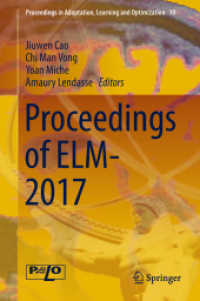- ホーム
- > 洋書
- > 英文書
- > Architecture
Full Description
In architecture, composition refers to the conception of a building according to principles of regularity and hierarchy, or according to the principles of obtaining equilibrium. However, it is not until the beginning of the nineteenth century that the notion of composition becomes truly associated with architectural conception, notably under the influence of Jean-Nicolas-Louis Durand and his statement on the Marche à suivre dans la composition d'un project quelconque [Procedure to be followed in the composition of any project]. The concept quickly erodes during the twentieth century, with the adoption of neutral architectural devices, the use of aggregative processes, and the adoption of "objective" operations, all of which can be understood as an attempt to move beyond compositional principles.
In Composition, Non-Composition, Jacques Lucan invites his readers to consider this novel historical perspective of architectural theory. The author describes the interaction of ideas that often clash with one another, with some that fade away as others emerge, thus offering invaluable keys to understanding contemporary architecture. Although this book is primarily addressed to students of architecture, it will also appeal to architects, historians of architecture, as well as to the interested public.
Contents
1. Distribution, Disposition, Composition Part I: Closed Order 2. "Procedure to Be Followed in the Composition of Any Project" - Jean-Nicolas-Louis Durand Part II: Symmetry and Hierarchy 3. Symmetrical Suites and Interior Landscapes 4. To Compose an Ensemble 5. Compositional Hierarchy and Intelligibility Part III: The Beaux-Arts System 6. The Ateliers 7. Les Concours 8. Architectural Theory Part IV: The Composition, beyond styles 9. A Theory of La Pièce - Julien Guadet 10. Implicit Principles 11. The End of the École de Beaux-Arts System 12. The American Deviation Part V: New Paradigm - The Construction 13. Systems of Architecture 14. The Architectural Organism - Eugène Viollet-le-Duc 15. Modern Construction - Composition or Growth Part VI: New Paradigm - Irregularity 16. Composition and Juxtaposition 17. Composition and Picturesque 18. Formal, Informal Part VII: Open Order 19. Composition and Parcours 20. Convex Space - Le Corbusier and the Free Plan 21. The Enclosure Breached 22. Painting and Architecture 23. Collage and Assemblage Part VIII: Between Composition and Non-Composition 24. Grid and Neutrality 25. Aggregative Structures and the Non-Plan 26. The Room and Beyond - Louis I. Kahn 27. Concavity and Convexity, Once Again 28. Formalism and Linguistic Paradigm 29. Process and Program Versus Composition - Rem Koolhaas 30. Operation Versus Composition - Unitary Form and Interdependence of Elements Index








